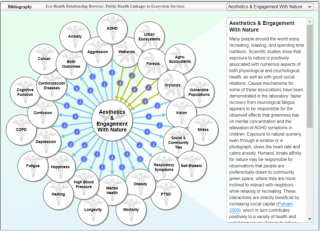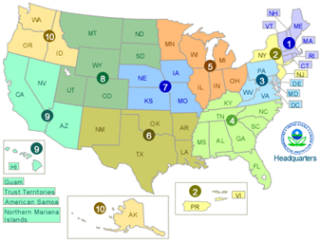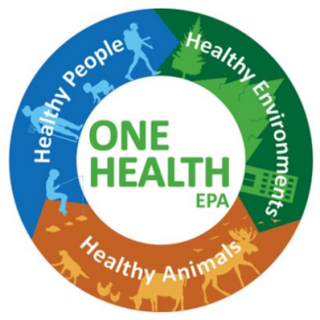Leading One Health at EPA
The mission of EPA is to protect human health and the environment. From its inception, EPA has exemplified the principles of One Health, recognizing the interdependence of the health of humans, animals, and the environment. Essentially, when EPA protects the environment (air, water, and soil), EPA is protecting humans, animals, crops, and ecosystems.
The U.S. Centers for Disease Control and Prevention defines One Health as a collaborative, multisectoral, and transdisciplinary approach that that recognizes that the health of people is closely connected to the health of animals and our shared environment. Applying a One Health perspective to our EPA mission requires all of us to apply existing science to address the challenges faced today, while researching and developing new scientific techniques to address the developing challenges of tomorrow.
The One Health Concept

Initially, the concept of One Health gained popularity among scientists studying diseases transmitted from animals to humans. However, it was soon evident that a broader understanding of the diseases and health challenges shared between humans and animals was needed; an understanding that was based on a deeper examination their shared environment. In recent years, the scope of One Health has been expanded to allow an integrated approach for diverse scientific disciplines to work together on today’s complex environmental problems such as climate-related stressors, harmful algal blooms, and biodiversity loss.
To facilitate coordination across all of EPA, the EPA One Health Coordination Team (OHCT) was established in Fall 2022. The OHCT is comprised of EPA volunteers from across the agency. The team is highly diverse in terms of disciplinary backgrounds, EPA program expertise, geographical locations, and demographics. This team includes toxicologists, biologists, chemists, ecologists, and environmental protection specialists. The OHCT strives to connect One Health activities (research, response, and regulatory) within the EPA, establish strategic partnerships with new and existing collaborators, and foster internal and external education on One Environment - One Health-related topics.
Making Tribal Connections in the Regions

Indigenous communities have collected knowledge and traditional practices over countless generations living in harmony with nature. This profound understanding of ecosystems and sustainable resource management is well aligned with the principles of One Health. Our team recognizes the immeasurable value of Indigenous knowledge and is committed to partnering with these groups as part of EPA’s One Health approach. OHCT has a dedicated position to foster and coordinate with EPA Tribal programs to establish regional and tribal connections.
In December 2022, OHCT members participated in the ORD Tribal Science Council Meeting to gain better understanding of tribal environmental challenges and tribal efforts to protect the environment. In March 2023, OHCT met with Region 5 to explore opportunities for collaboration between One Health and Indigenous Knowledges and practices in the region. By making these valuable connections, our team seeks to build and sustain a One Health approach that embraces the vital contributions of Indigenous communities.
Partners in the One Health Approach
Since 2021, EPA has partnered with the Environmental Council of the States (ECOS), the Association of State and Territorial Health Officials (ASTHO), and the Association of Fish and Wildlife Agencies (AFWA) to promote and advance the One Health approach among state environmental, health, and fish and wildlife agencies. Together, we’ve hosted webinars and workshops, which led to the creation of an ongoing community of practice focusing on the environmental pillar of One Health and missions relevant to EPA, ECOS, ASTHO, and AFWA.
Discover One Health Initiatives

EPA program offices and regions are doing important One Health work. It is easy to find multiple “One Health in Action” stories, such as:
- Office of Air and Radiation’s new Clean School Bus Program
- Office of Chemical Safety and Pollution Prevention’s EPA Risk Assessments to Protect Bees and Other Pollinators from Pesticides
- Office of Land and Emergency Management’s Food Waste and Recovery Toolkits
- Office of Research and Development’s EnviroAtlas, EcoHealth Browser, and Smoke Sense App
- Office of Water’s work on Harmful Algal Blooms (HABs), Wastewater Surveillance, and PFAS and Lead in Drinking Water
- Office of Children’s Health report: America’s Children and the Environment
Learn more about EPA’s One Health Approach or join the One Health Community of Practice

About the Author
Dr. Tonya Nichols
Senior Science Advisor
Office of Research and Development, Center for Environmental Solutions and Emergency Response
With more than 25 years of experience in microbiology and biodefense, Dr. Nichols serves as a Senior Science Advisor in the Center for Environmental Solutions and Emergency Response and as the One Health Coordinator for the US Environmental Protection Agency (EPA). Dr Nichols’ work focuses on building interagency collaborations and coordination with White House science policy workgroups related to health security and biodefense.
Editor’s Note: The views expressed here are intended to explain EPA policy. They do not change anyone’s rights or obligations. You may share this article. However, please do not change the title or the content, or remove EPA’s identity as the author. If you do make substantive changes, please do not attribute the edited title or content to EPA or the author.
EPA’s official web site is www.epa.gov. Some links on this page may redirect users from the EPA website to specific content on a non-EPA, third-party site. In doing so, EPA is directing you only to the specific content referenced at the time of publication, not to any other content that may appear on the same webpage or elsewhere on the third-party site, or be added at a later date.
EPA is providing this link for informational purposes only. EPA cannot attest to the accuracy of non-EPA information provided by any third-party sites or any other linked site. EPA does not endorse any non-government websites, companies, internet applications or any policies or information expressed therein.
